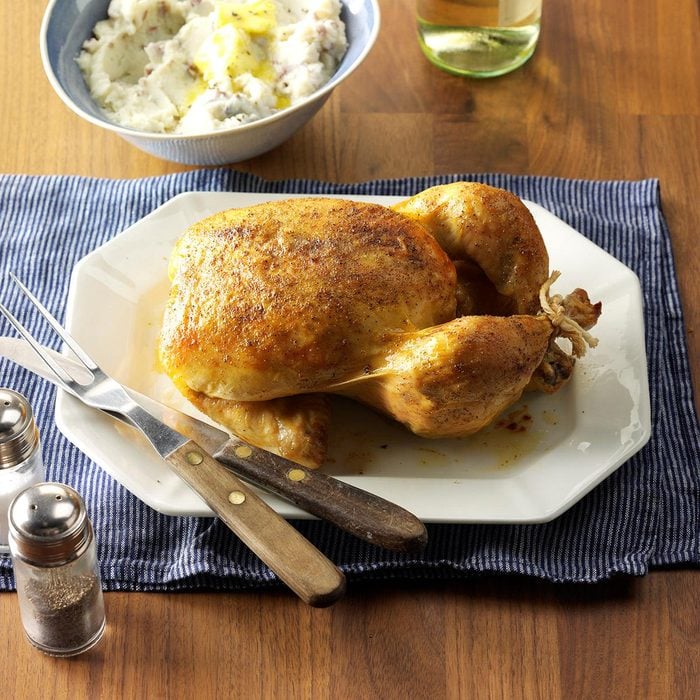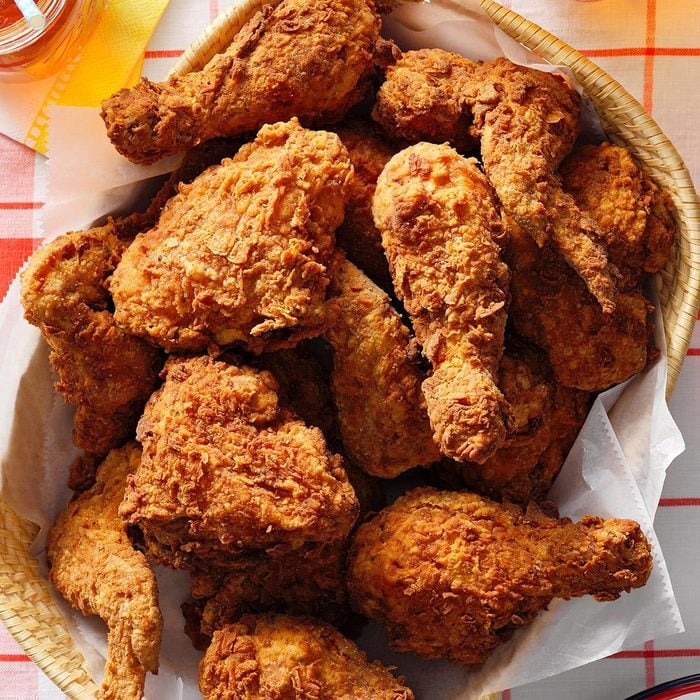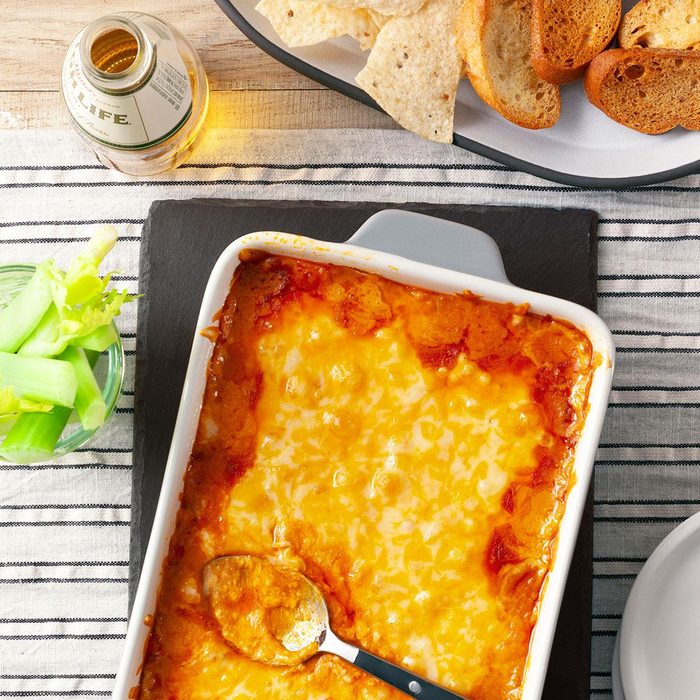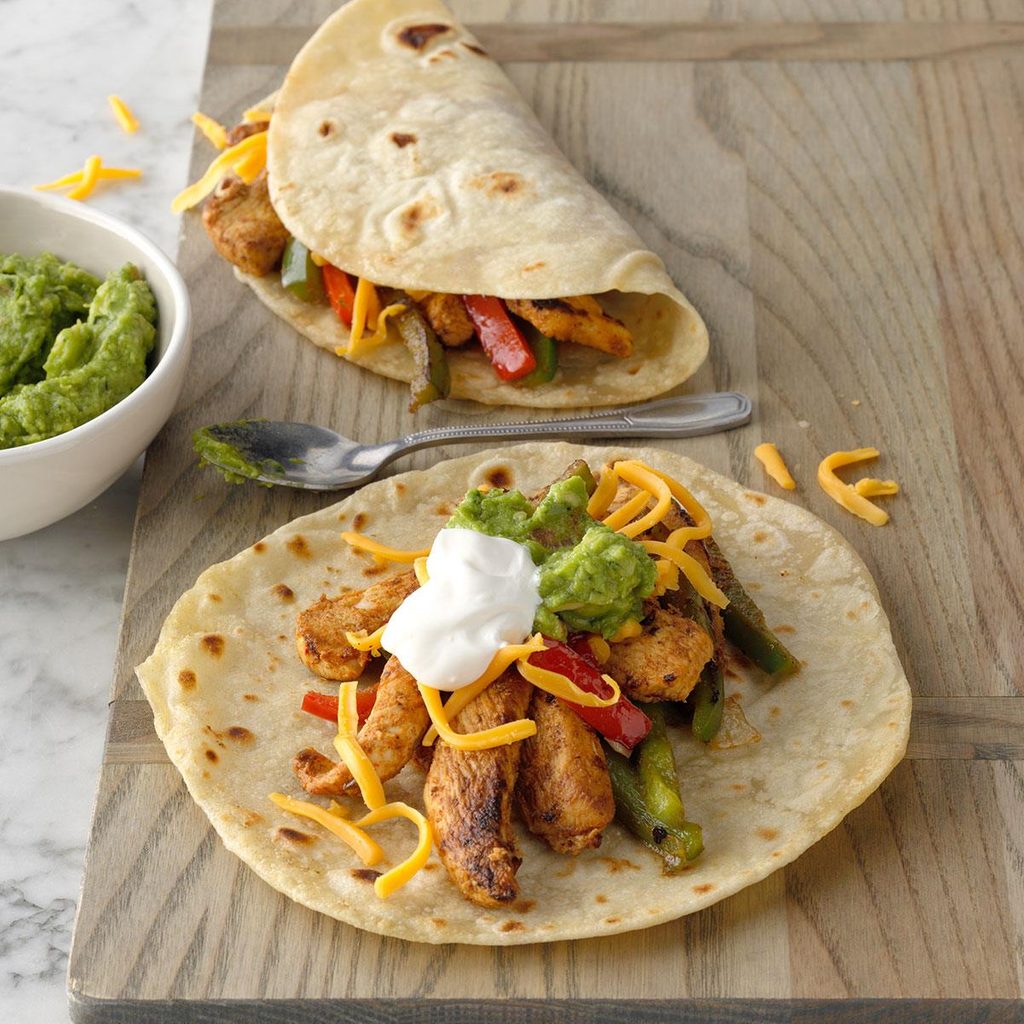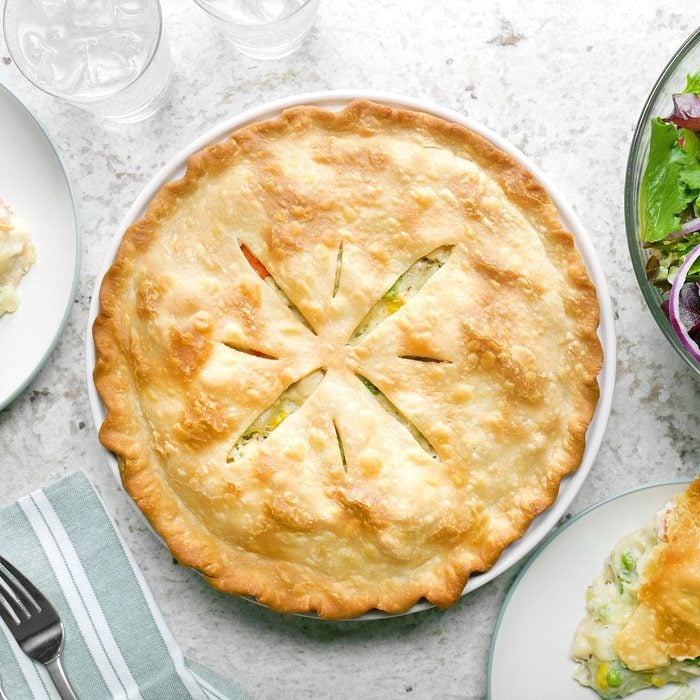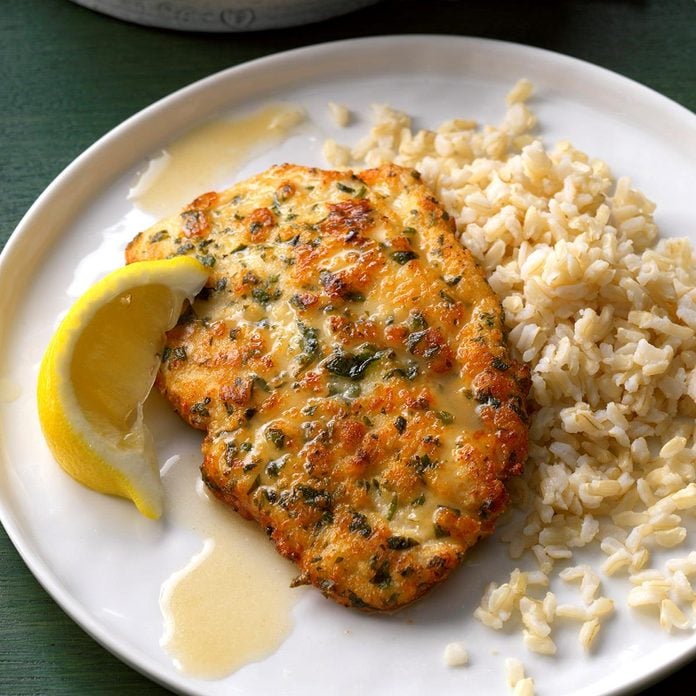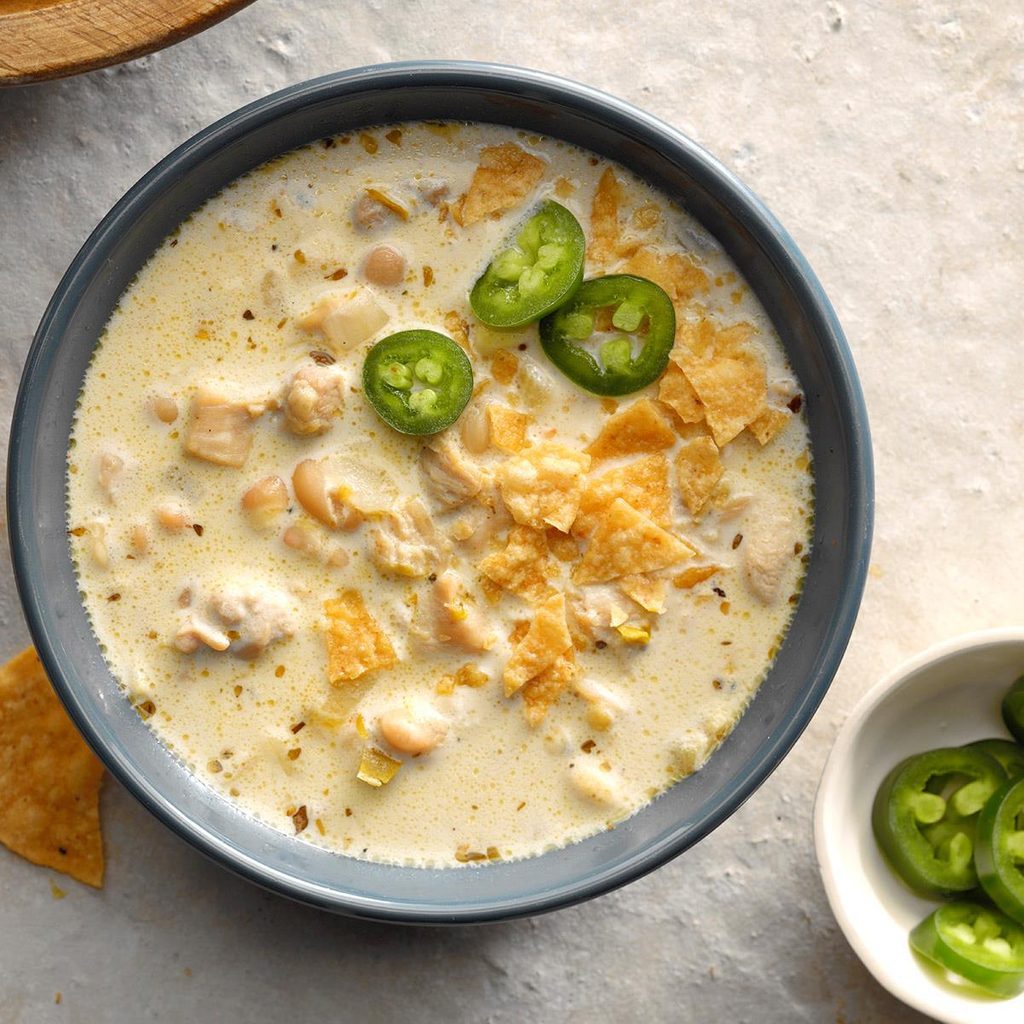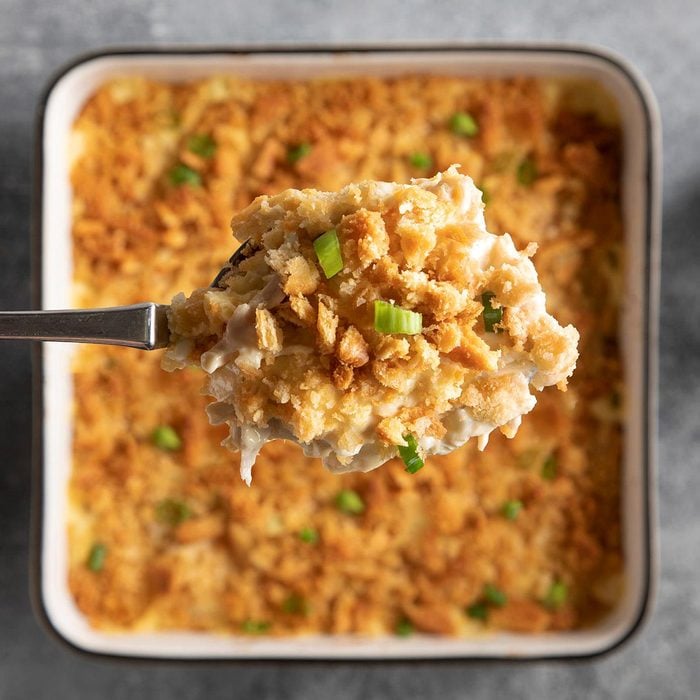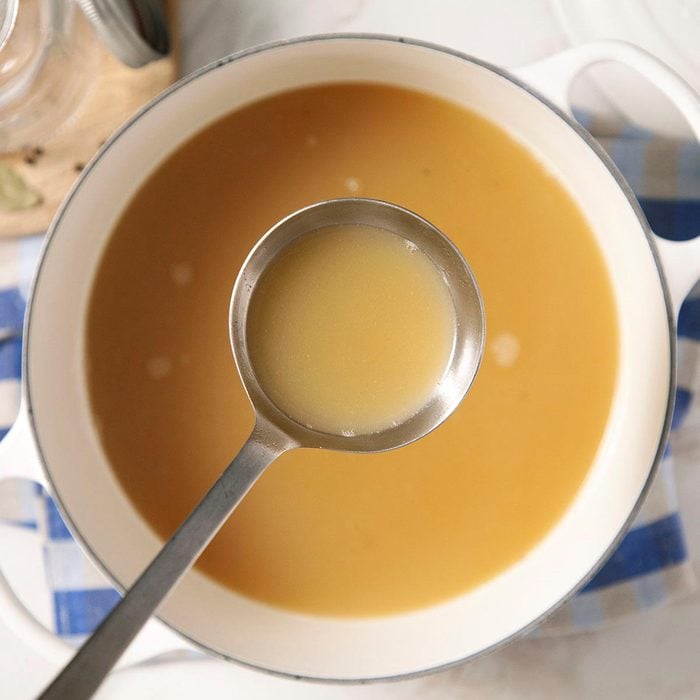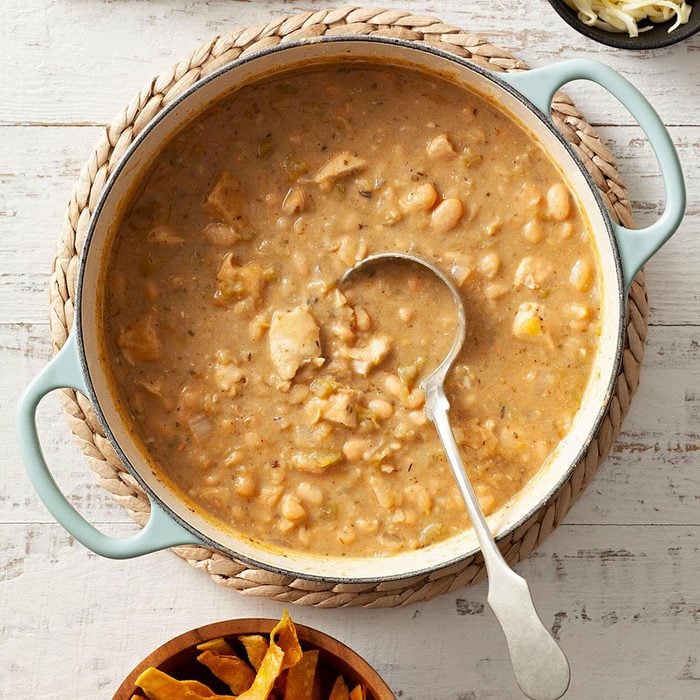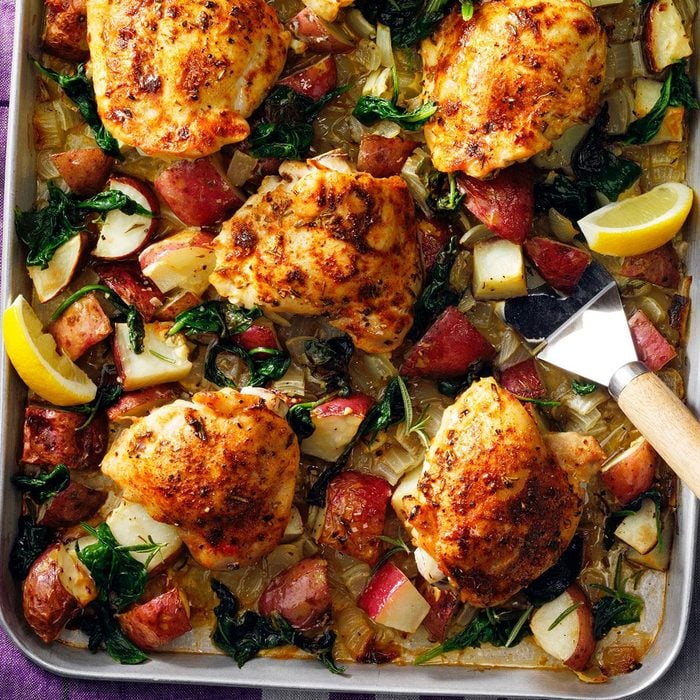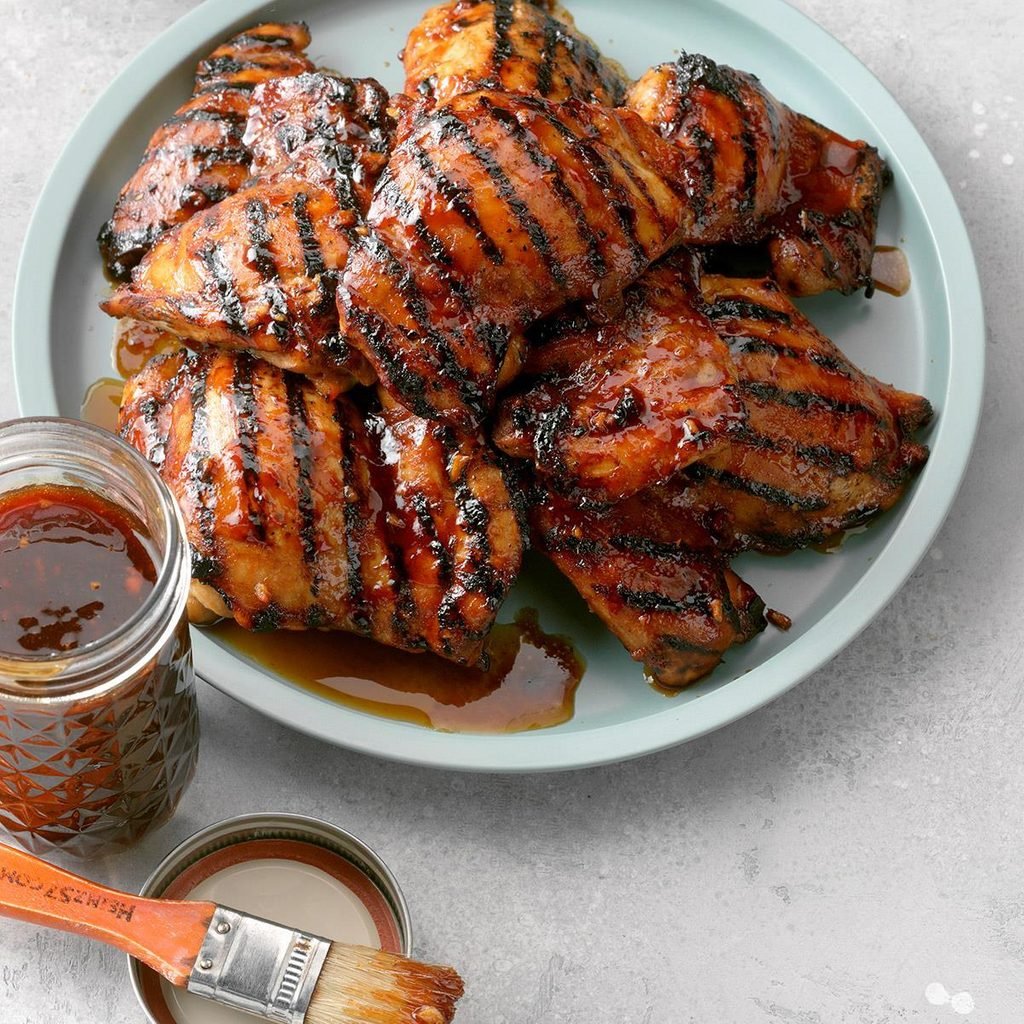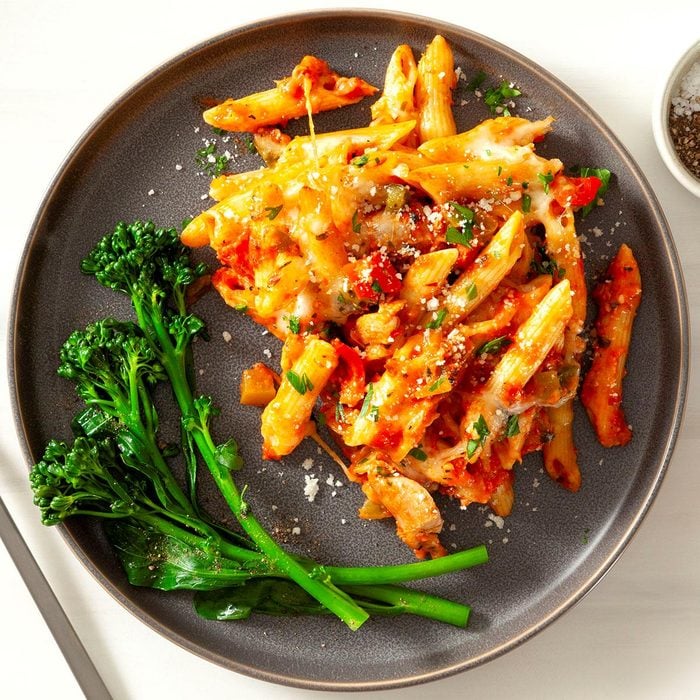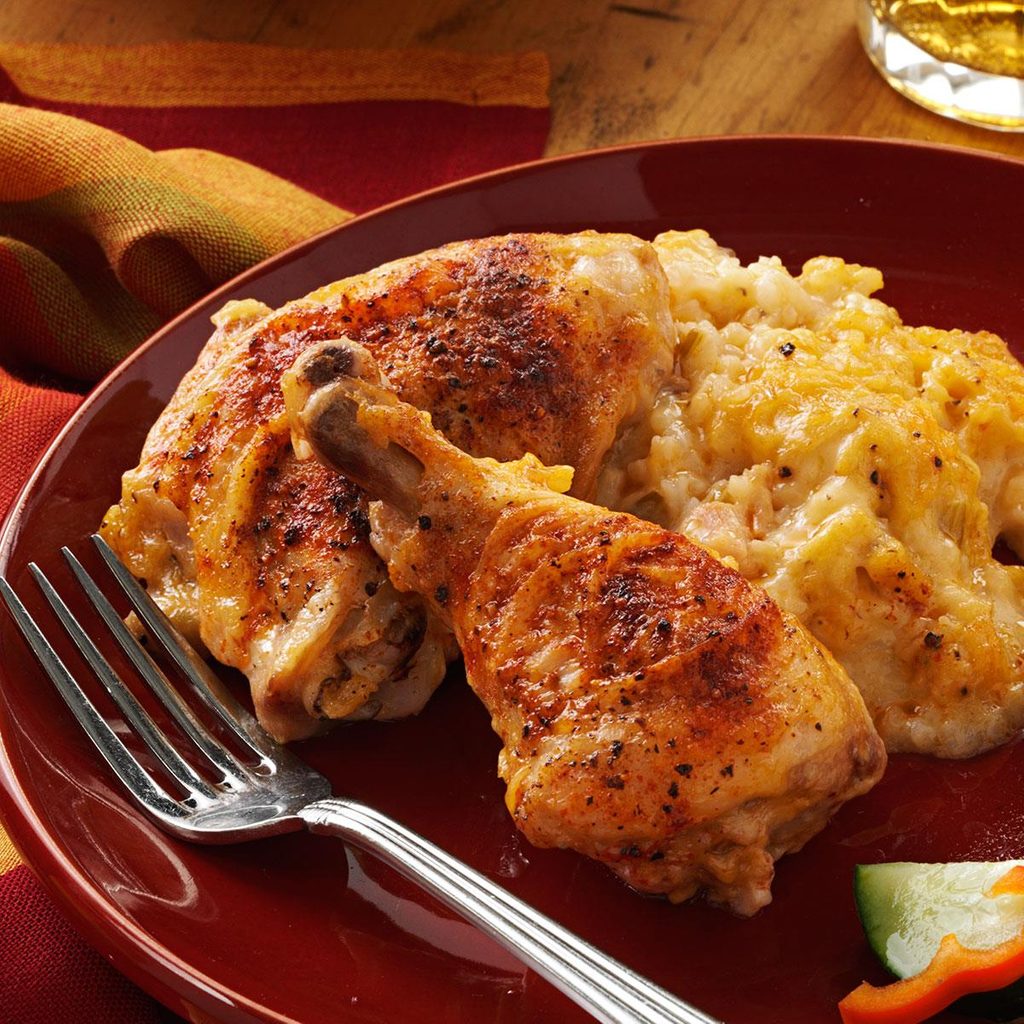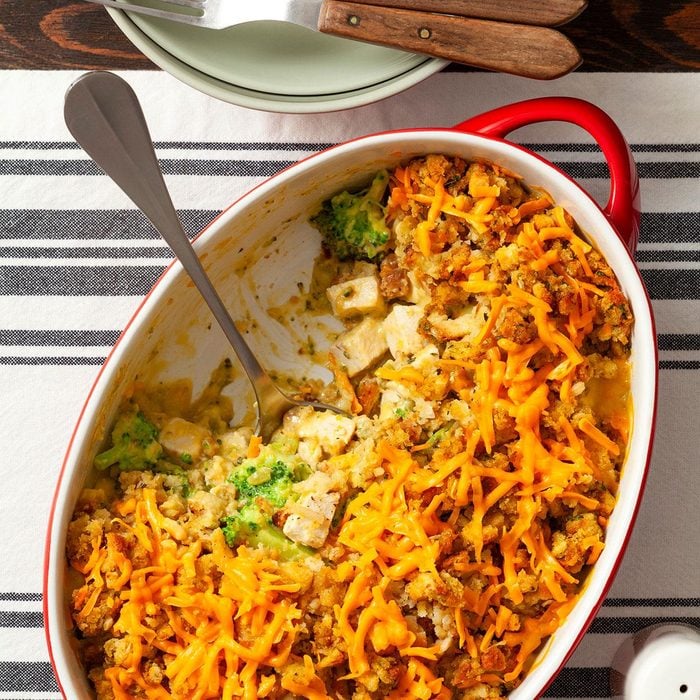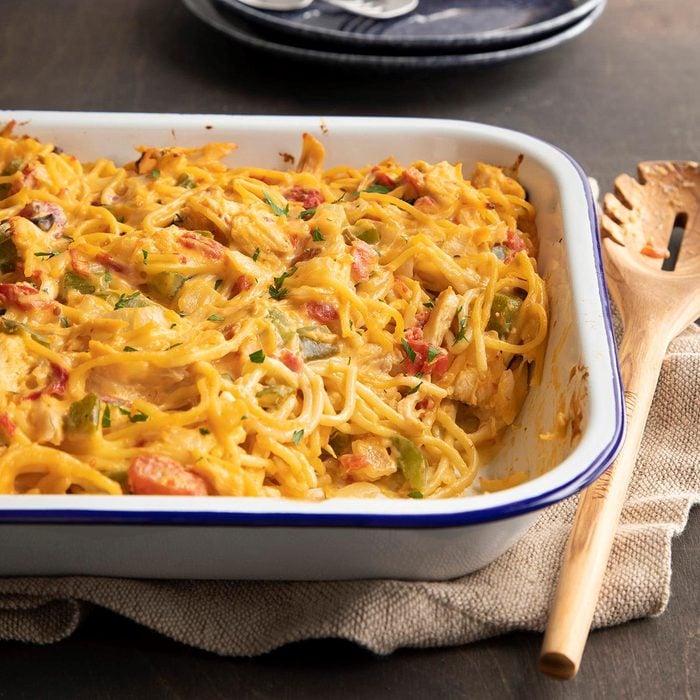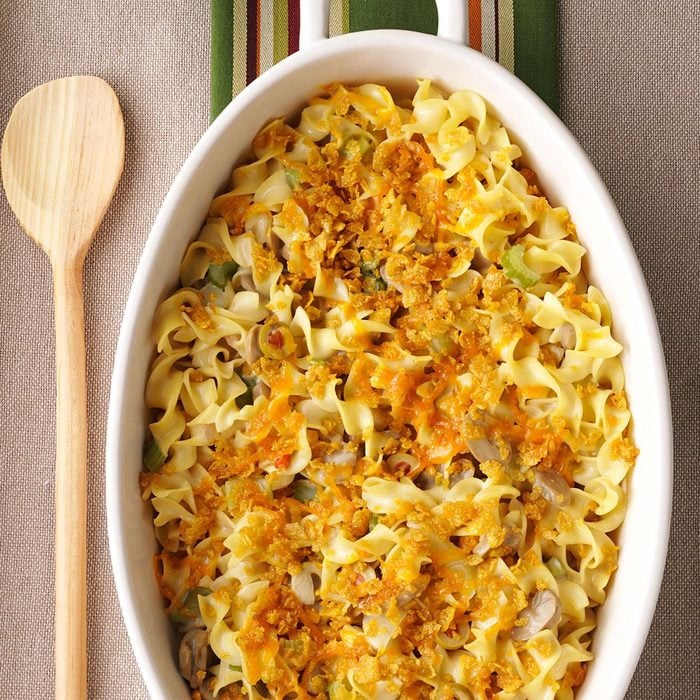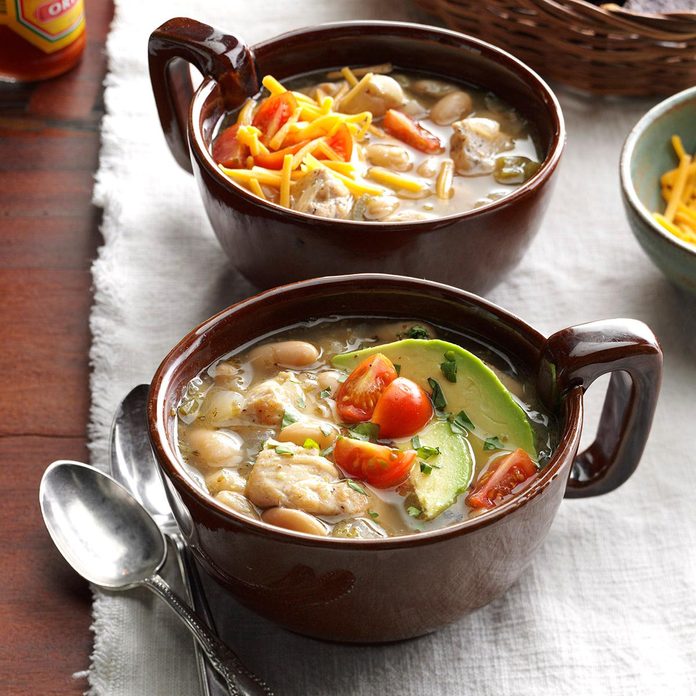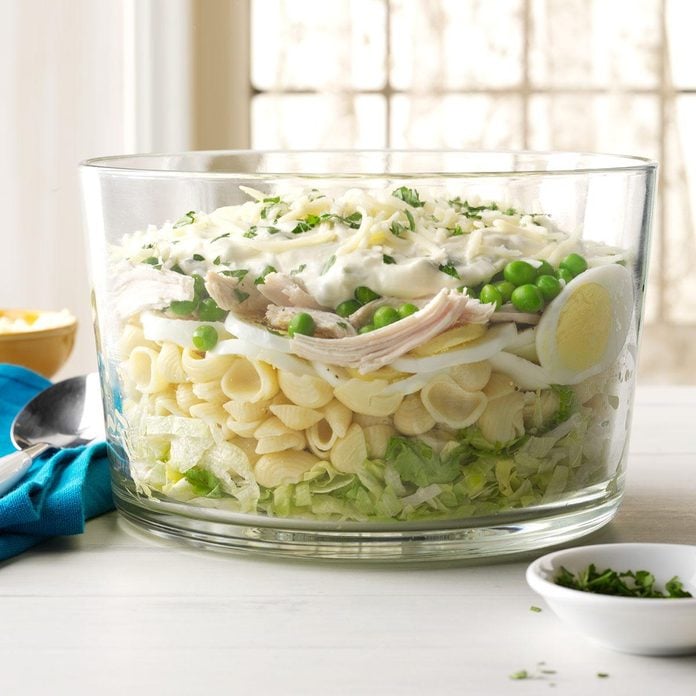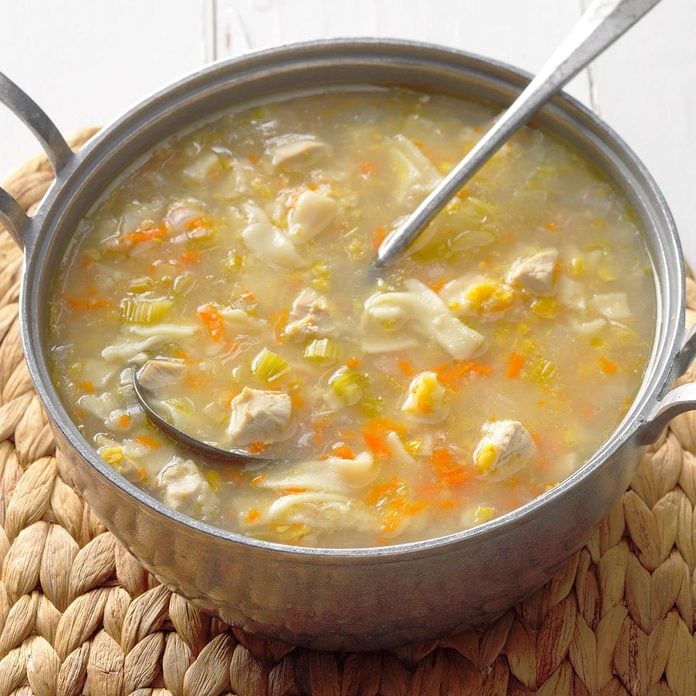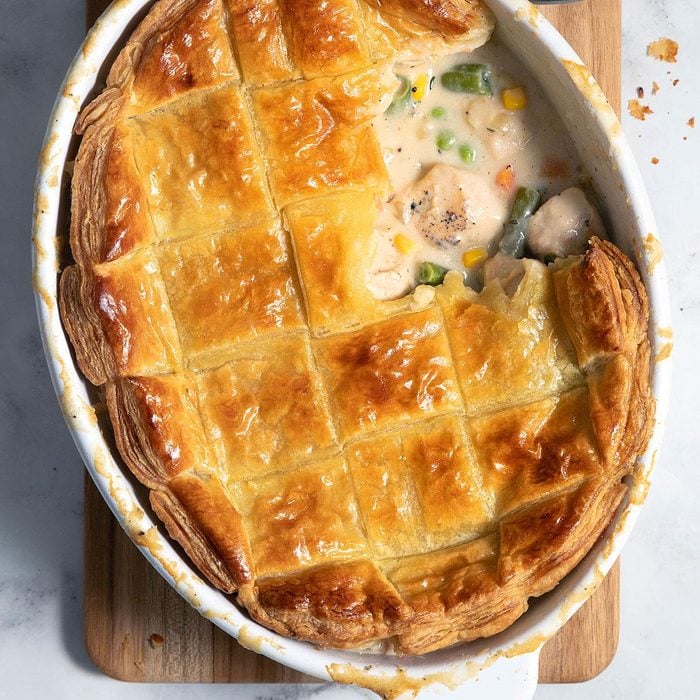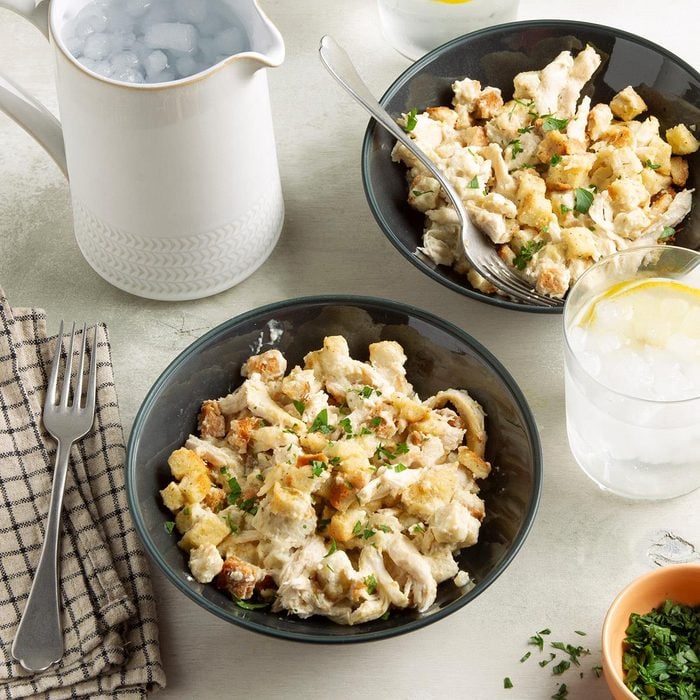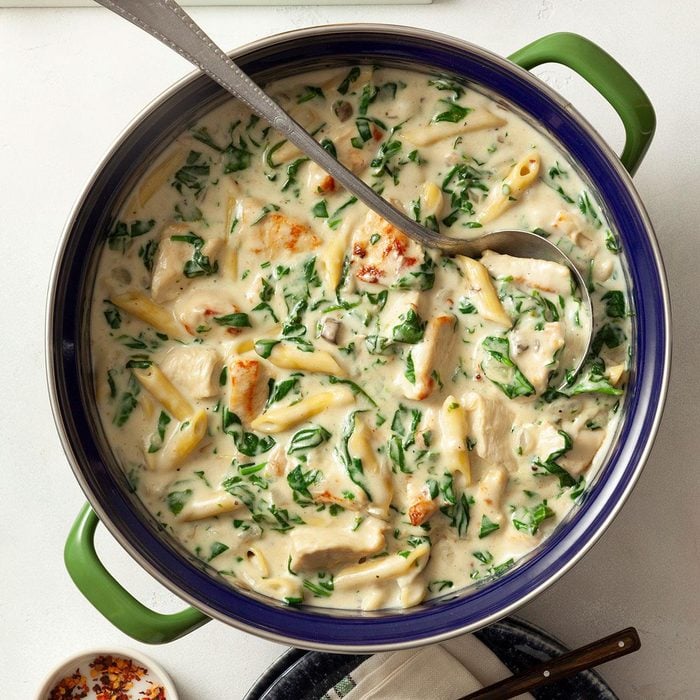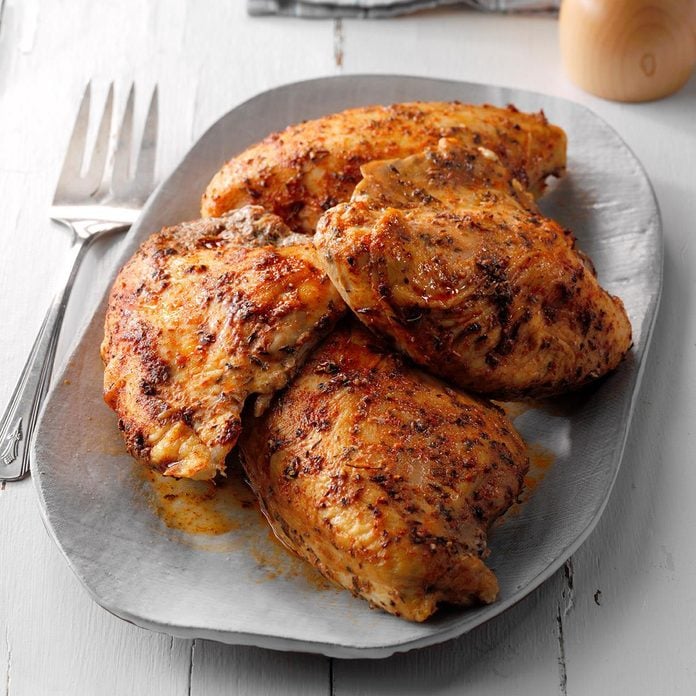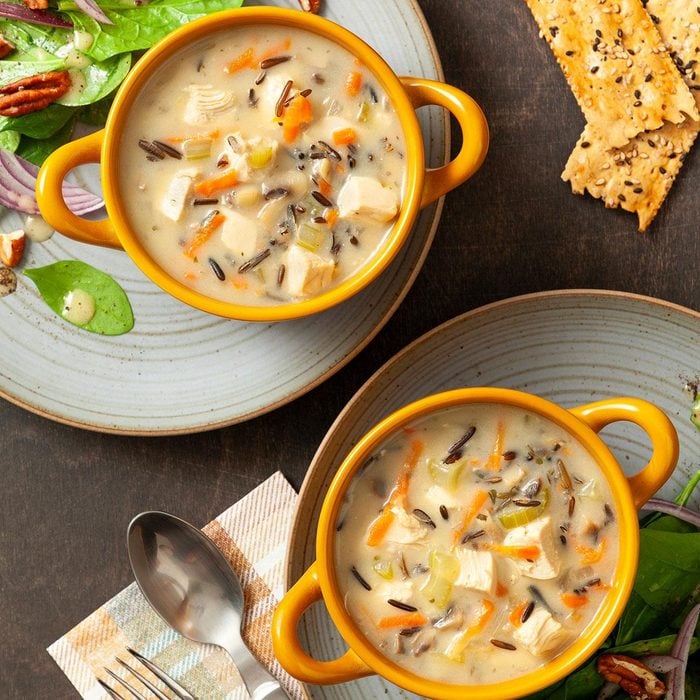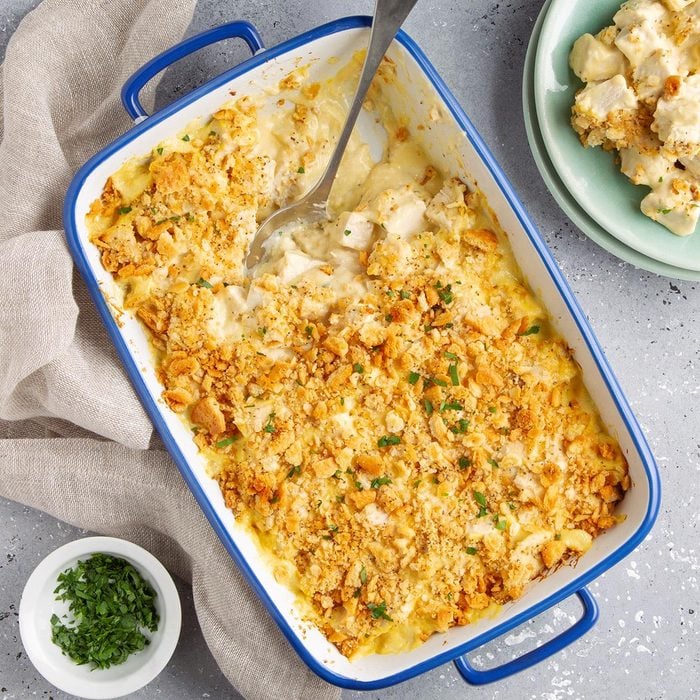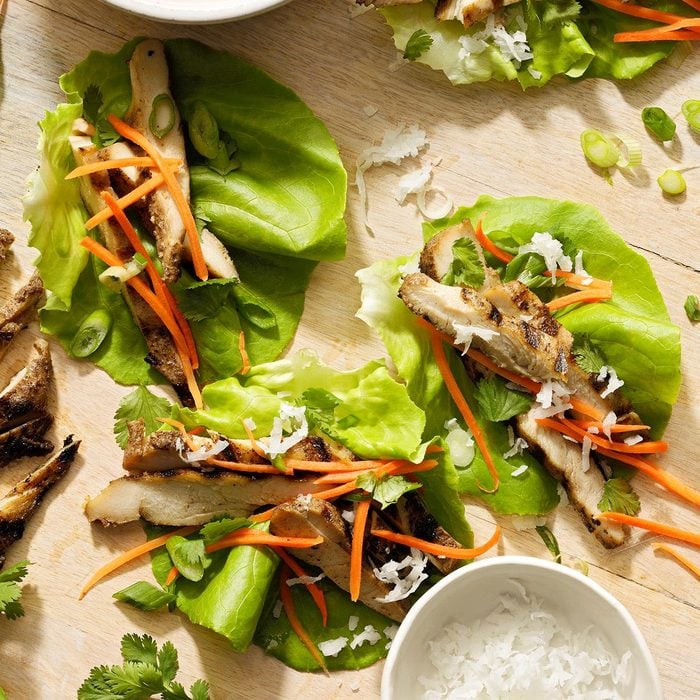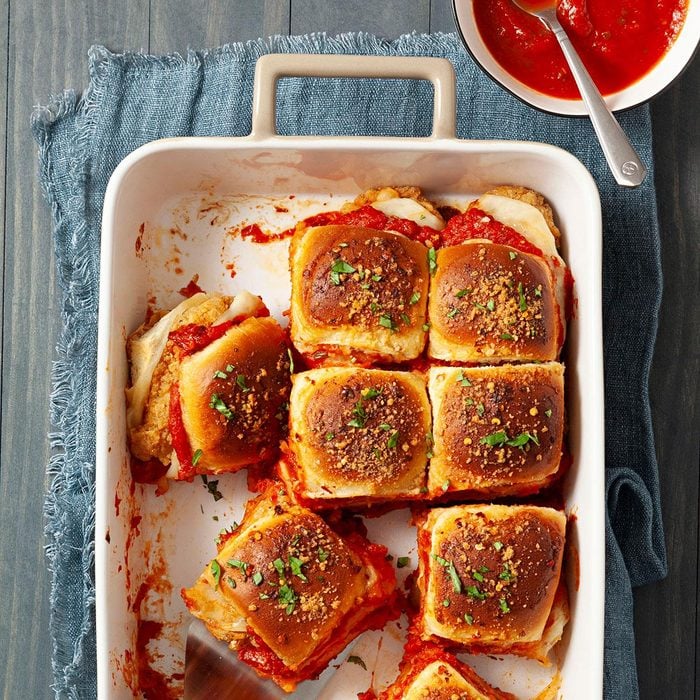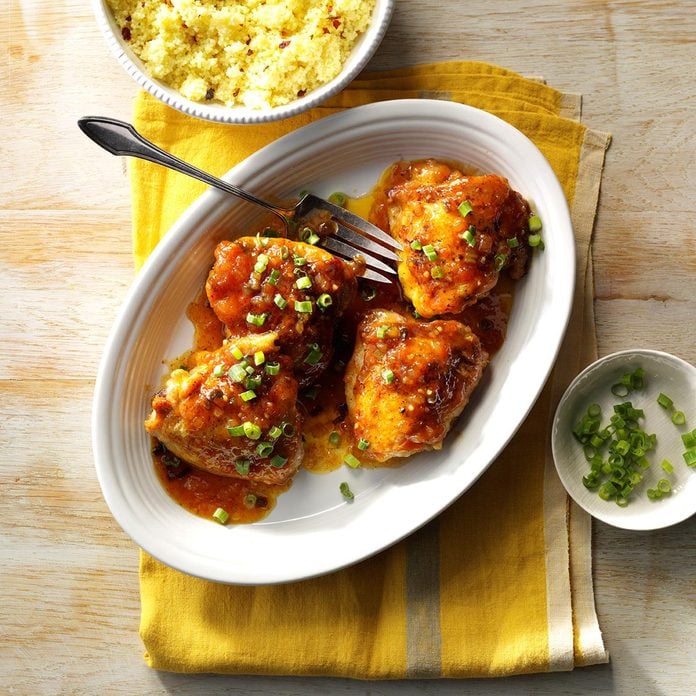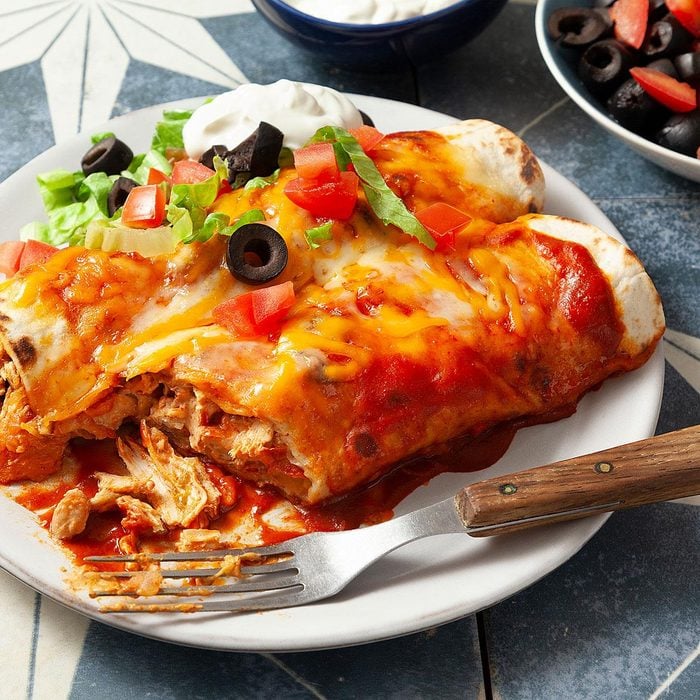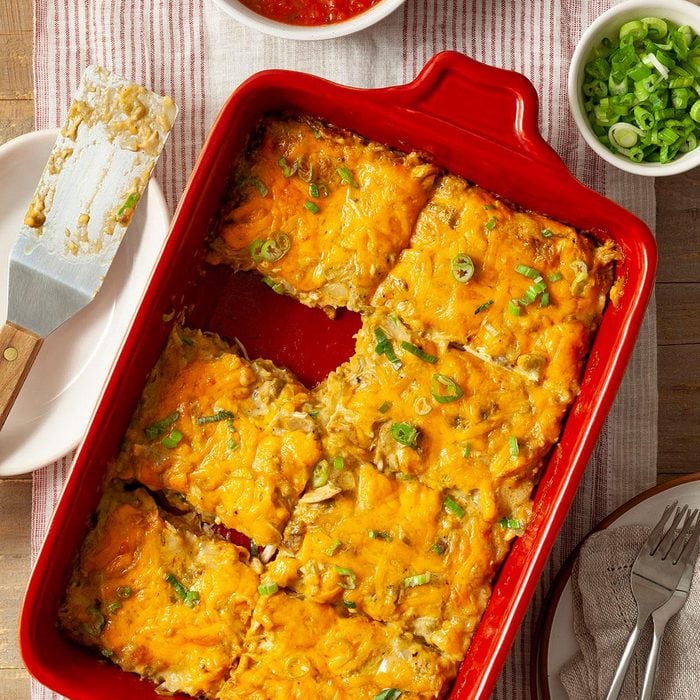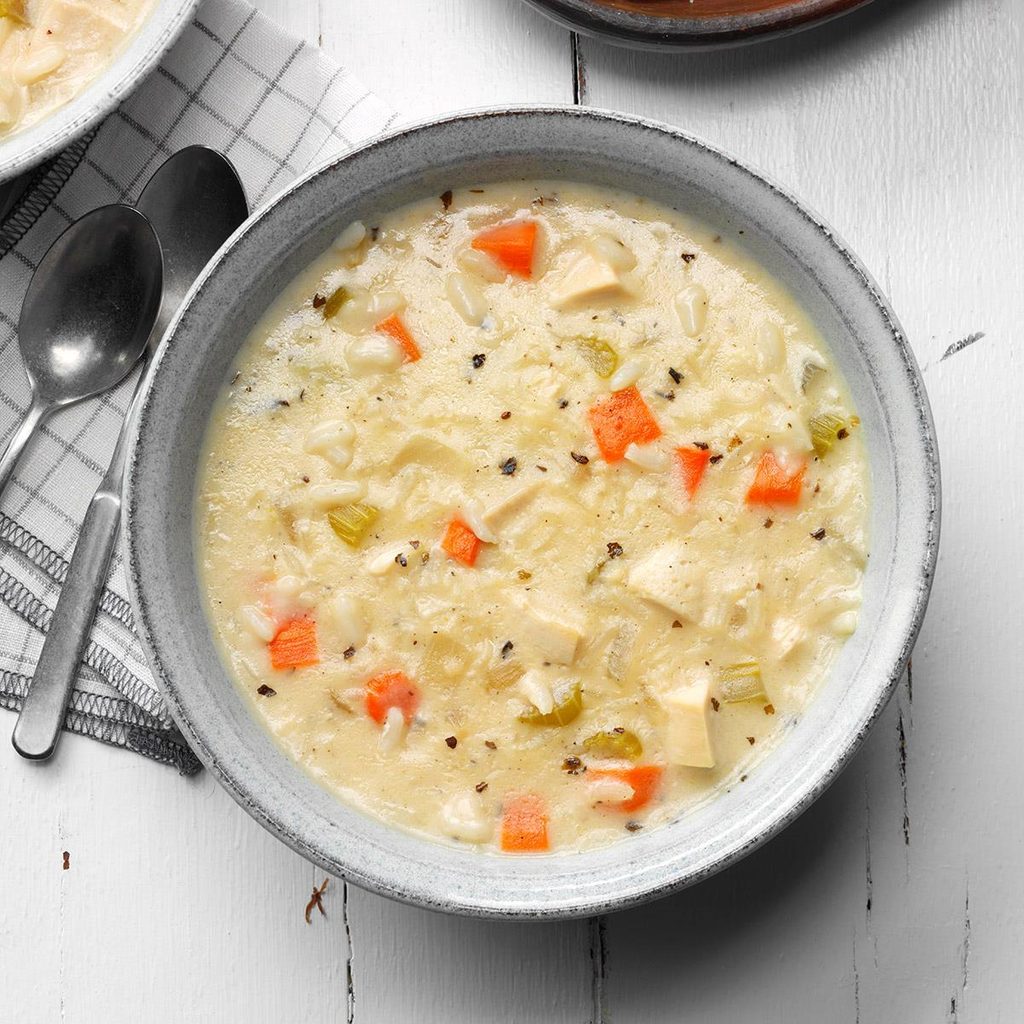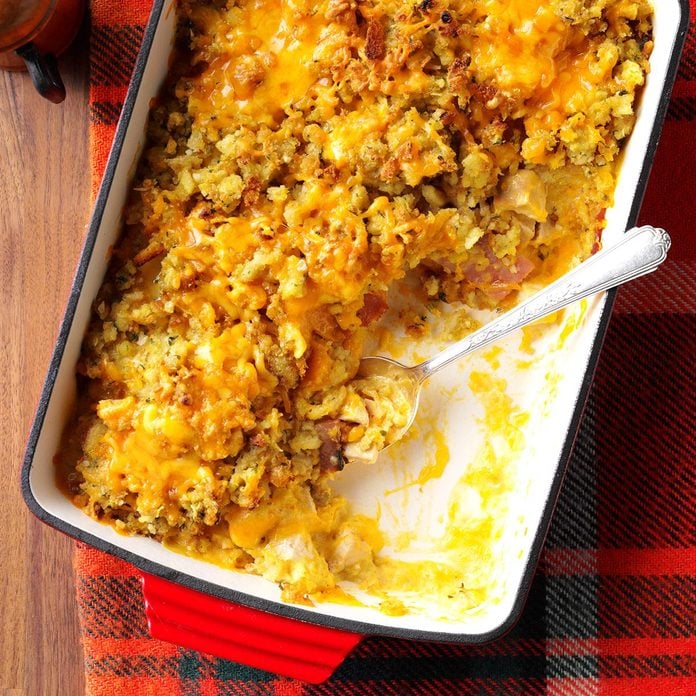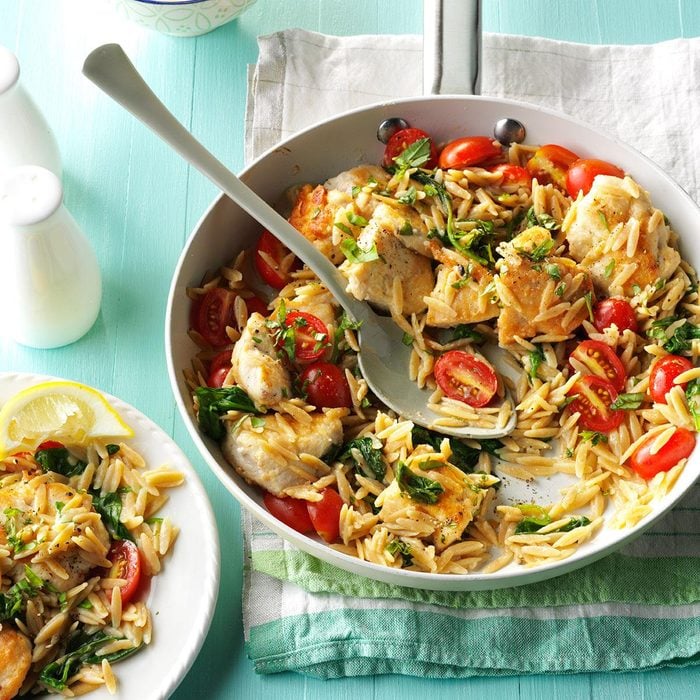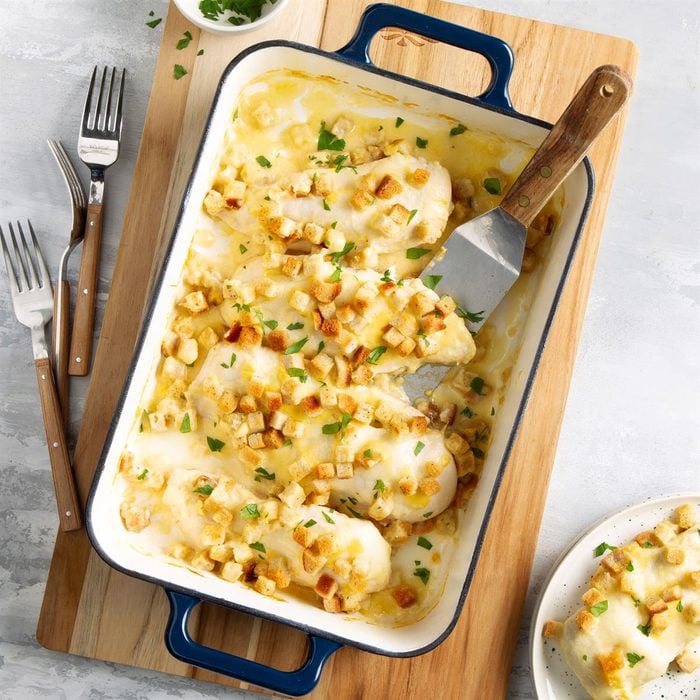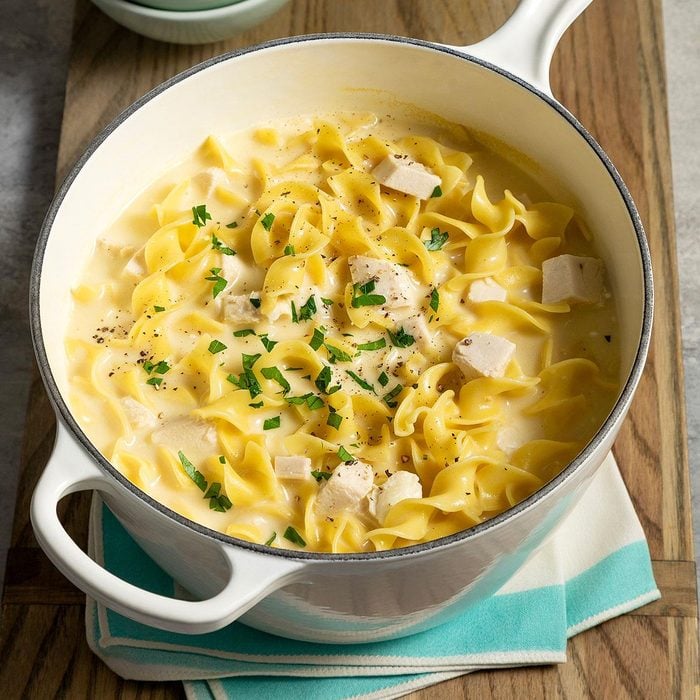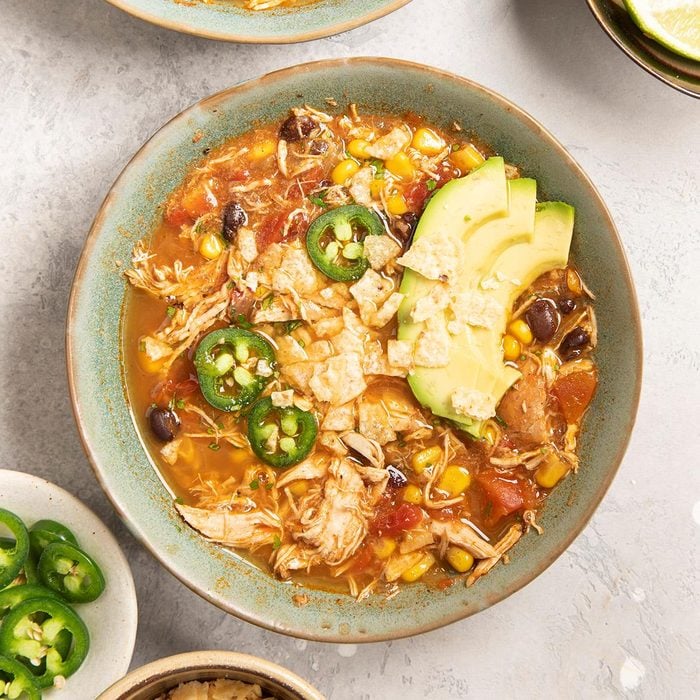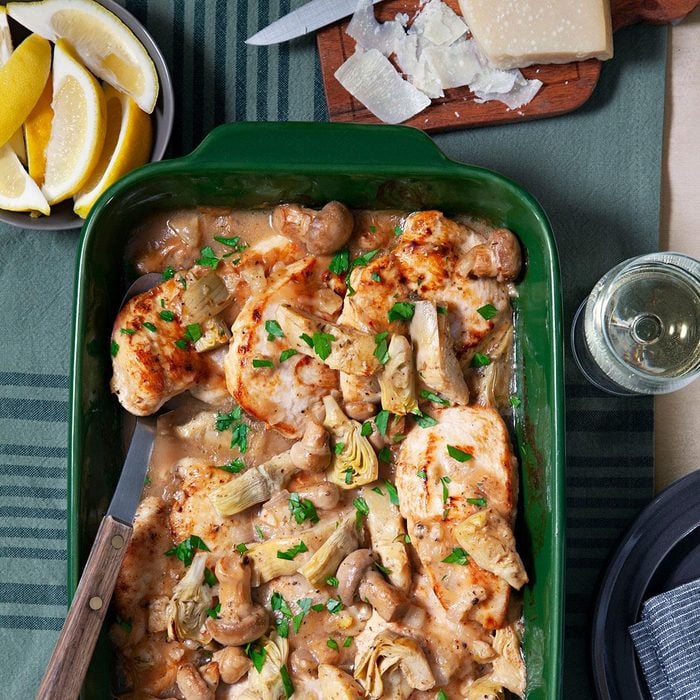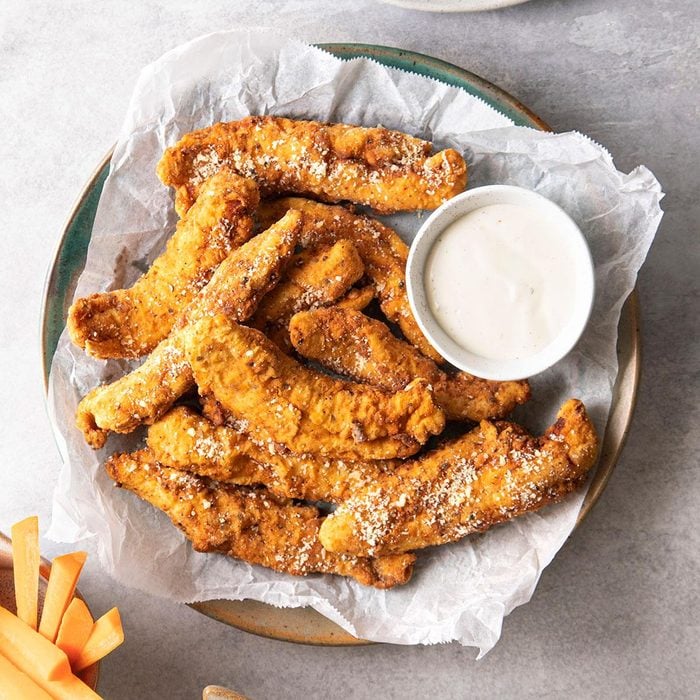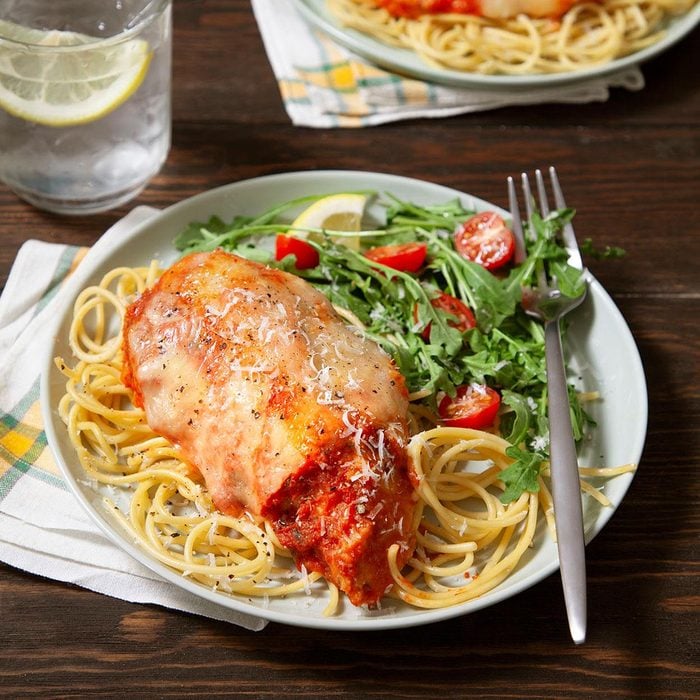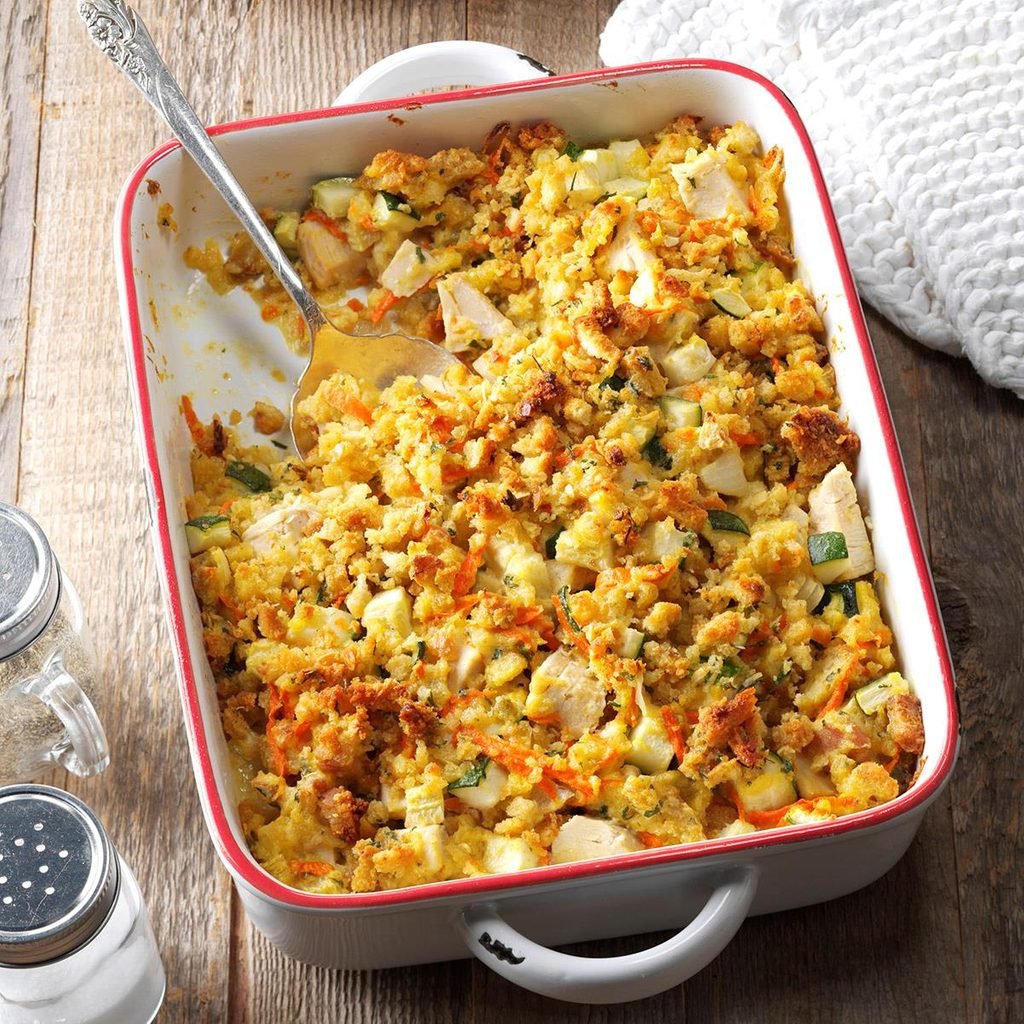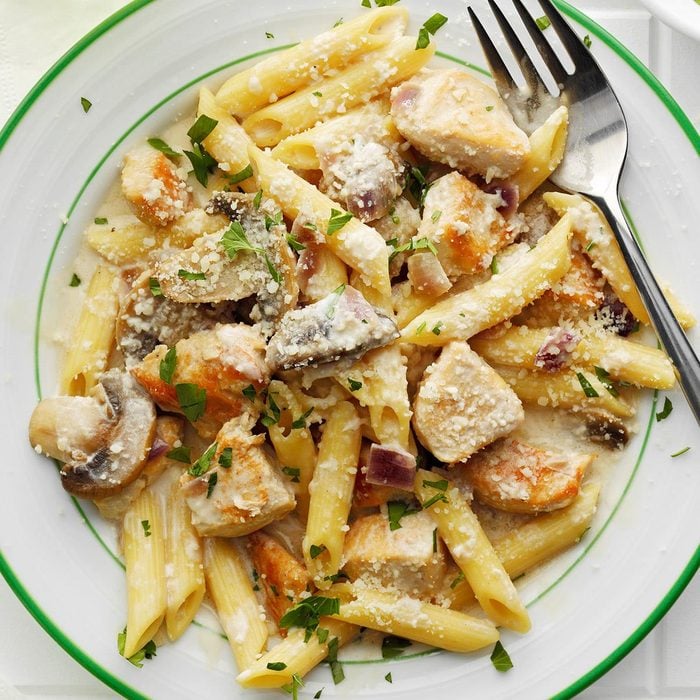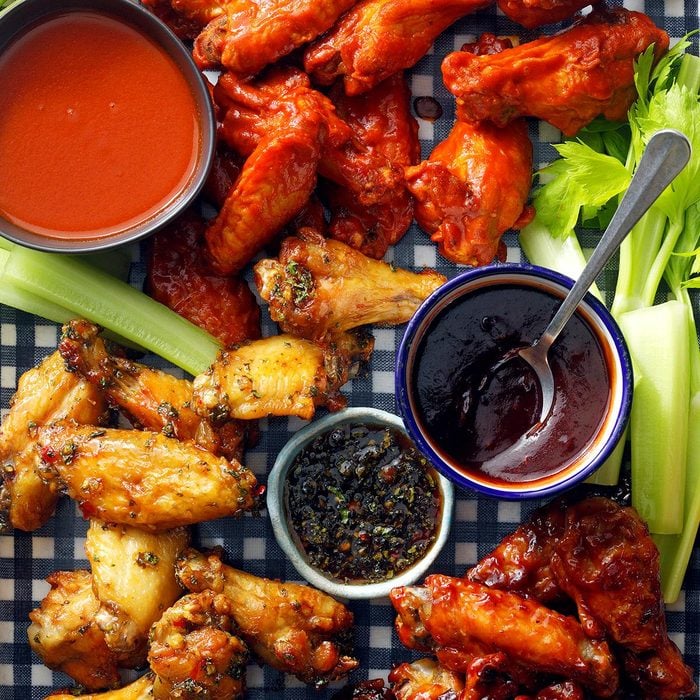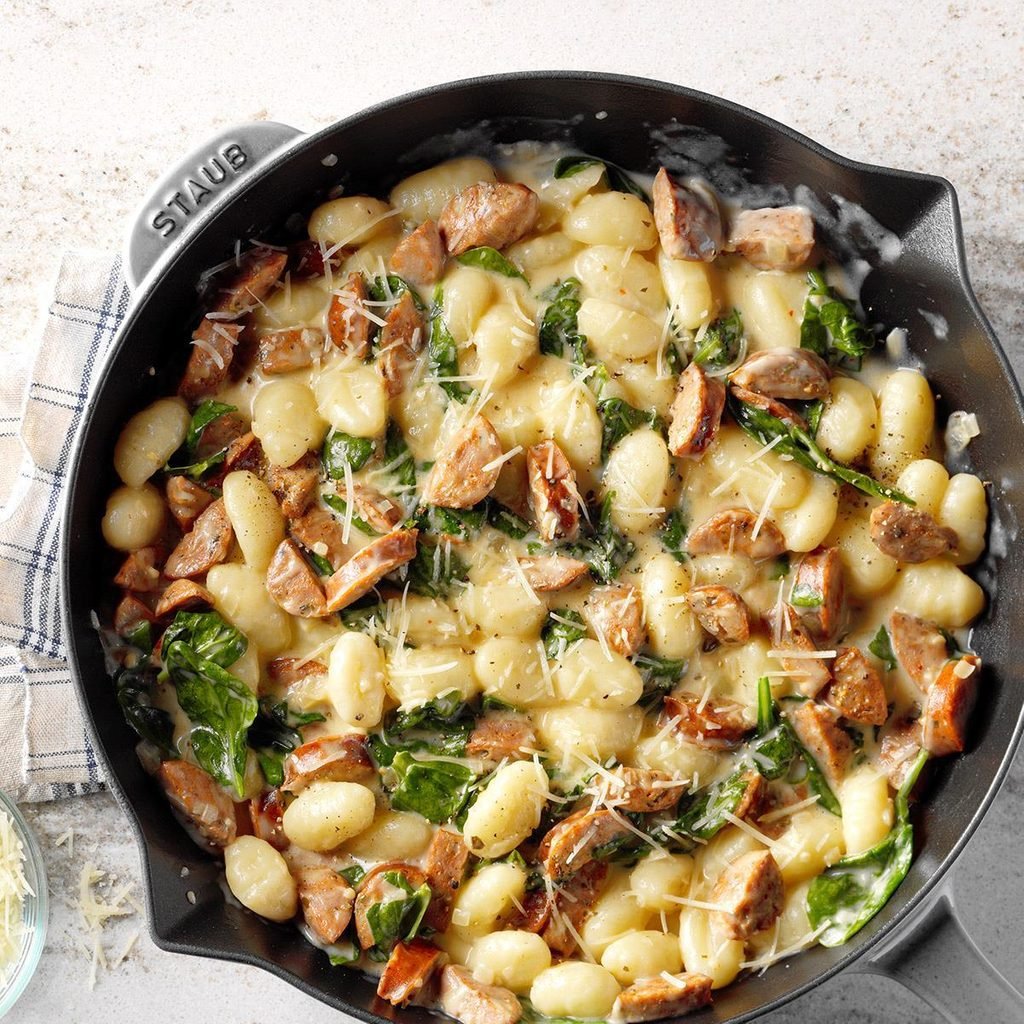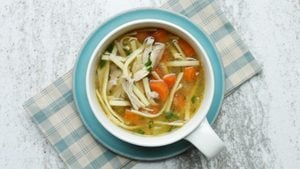 The Ultimate Chicken Noodle Soup
The Ultimate Chicken Noodle Soup
My first Wisconsin winter was so cold, all I wanted to eat was homemade chicken noodle soup. Of all the chicken noodle soup recipes out there, this
type of soup is my favorite and is in heavy rotation from November to April. It has many incredibly devoted fans. —Gina Nistico, Denver, Colorado
Editor's Tip: Check how long does cooked chicken last in the fridge.
Go to Recipe
Crispy Fried ChickenIf you've wanted to learn how to make crispy fried chicken, this is the recipe for you. Always a picnic favorite, this deep-fried chicken recipe is delicious either hot or cold. Kids call it my Kentucky Fried Chicken! —Jeanne Schnitzler, Lima, Montana
Wondering,
can you freeze chicken? It all depends on how it's prepared.
Buffalo Chicken DipThis is the best Buffalo chicken dip recipe! Whenever I bring Buffalo dip to a tailgate or potluck, everyone asks for the recipe. —Peggy Foster, Florence, Kentucky
Flavorful Chicken FajitasThis chicken fajitas recipe is definitely on my weeknight dinner rotation. The marinated chicken in these popular wraps is mouthwatering. The fajitas go together in a snap and always get raves! —Julie Sterchi, Campbellsville, Kentucky
Best Chicken PotpieThis is the best chicken potpie recipe! Chock-full of chicken, potatoes, peas and corn, this recipe makes two golden pies, so you can serve one at supper and save the other for a busy night. —Karen Johnson, Bakersfield, California
Chicken Piccata with Lemon SauceOnce you've tried this tangy, yet delicate lemon chicken piccata, you won't hesitate to make it for company. Seasoned with parmesan and parsley, the chicken cooks up golden brown, then is drizzled with a light lemon sauce. —Susan Pursell, Fountain Valley, California
Creamy White ChiliYears ago, as a time-starved college student, I got this wonderful recipe from my sister-in-law. She had made a big batch and served it to a crowd one night. It was a hit—and easy and quick. In all my years of cooking, I’ve never had another dish get so many compliments. —Laura Brewer, Lafayette, Indiana
Million-Dollar Chicken CasseroleEveryone at the table will love this family-friendly dish. Million-dollar chicken casserole is easy to mix together and get on the dinner table on busy weeknights. Stir in shredded cheddar, mozzarella or Monterey Jack cheese for extra flavor. —
Taste of Home Test Kitchen
Homemade Chicken BrothWondering how to make chicken broth at home? Learn here! Rich in chicken flavor, this traditional broth is lightly seasoned with herbs. Besides making wonderful chicken soups, this chicken stock recipe can be used in casseroles, rice dishes and other recipes that call for chicken broth. —Taste of Home Test Kitchen
White Chicken ChiliFolks will enjoy a change from traditional chili when they dip their spoons into this flavorful blend of tender chicken, white beans and just enough zip. This is our favorite white chicken chili recipe. —Taste of Home Test Kitchen
Also, for dinner tonight, whip up one of our quick and delicious
chicken tenderloin recipes. You'll have a meal on the table in no time!
Sheet-Pan Chicken and VegetablesThis sheet-pan chicken and veggies meal tastes as if it took hours of hands-on time to put together, but the simple ingredients can be prepped in mere minutes. The rosemary gives it a rich flavor, and the meat juices cook the veggies to perfection. It’s unbelievably easy! —Sherri Melotik, Oak Creek, Wisconsin
Grilled Huli Huli ChickenI got this grilled chicken recipe from a friend while living in Hawaii. It sizzles with the flavors of brown sugar, ginger and soy sauce.
Huli means "turn" in Hawaiian. This sweet and savory glaze is fantastic on pork chops, too. —Sharon Boling, San Diego, California
Chicken Penne CasseroleThis is my family’s favorite every week or two and we never tire of it. I like that I can put it together and relax while it bakes. —Carmen Vanosch, Vernon, British Columbia
Sunday ChickenThis was my mother's favorite recipe for Sunday—hence the name. It makes an excellent recipe for Sunday dinner, because it can be prepared ahead of time and left to bake while you attend church. The leftovers also freeze well. —Don Harksen, Dothan, Alabama
Contest-Winning Broccoli Chicken CasseroleThis delicious chicken and broccoli casserole recipe is a twist on chicken divan that came from an old boss. It’s quick, satisfying comfort food. —Jennifer Schlachter, Big Rock, Illinois
Texas Chicken SpaghettiThis recipe for Texas chicken spaghetti was given to me years ago by a favorite sister-in-law, a wonderful cook. My whole family has the recipe and enjoys it too. It is easy to freeze or it can be made the day before and kept in the fridge. You can use two cans of cream of mushroom soup instead of one mushroom and one chicken. —Virginia Chamblin, Youngsville, Louisiana
Chicken CasseroleThe original old family recipe for this chicken casserole called for the sauce to be made from scratch. Through the years, I developed this version that takes less time to prepare and still tastes great. It's an attractive main dish. —Ruth Van Dyke, Traverse City, Michigan
White Bean Chicken ChiliMy sister shared this white bean chicken chili recipe with me. I usually double it and add one extra can of beans, then serve with cheddar biscuits or warmed tortillas. The jalapeno adds just enough heat to notice but not too much for my children. —Kristine Bowles, Albuquerque, New Mexico
Make-Ahead Hearty Six-Layer SaladThis salad is an all-time favorite. I reach for the recipe whenever I need a dish to pass. It is easy to make, can be assembled ahead of time and looks marvelous. —Noreen Meyer, Madison, Wisconsin
Amish Chicken Corn SoupCreamed corn and butter make my chicken corn soup homey and rich. This recipe makes a big batch, but the soup freezes well for future meals—one reason why soups are my favorite thing to make. —Beverly Hoffman, Sandy Lake, Pennsylvania
Slow Cooker Ranch ChickenThis is a fabulous slow-cooker ranch chicken recipe that we have passed around to all our friends, especially those who have young children. It's wonderful for a cold winter night or a hot summer day when you don't want to turn on the oven. Serve it as a weeknight family dinner or for a large group. —Sonya Stark, West Jordan, Utah
Puff Pastry Chicken PotpieWhen my wife is craving comfort food, I whip up this chicken pot pie with puff pastry. It's easy to make, sticks to your ribs and delivers soul-satisfying flavor. —Nick Iverson, Denver, Colorado
Chicken Rice BowlThis chicken rice bowl recipe is so easy to toss together on a busy weeknight, and I usually have the ingredients already on hand. I start sauteing the onion and pepper first, then I prepare the instant rice. If you like, top it with some shredded sharp cheddar cheese. —Tammy Daniels, Batavia, Ohio
Chicken Crouton CasseroleThis Chicken Crouton Casserole recipe has practically made my mom famous. When she takes it to get-togethers, it's loved by all who taste it. Whenever she serves it to family, the dish is empty by the end of the meal. —Beth Gramling, Warren, Pennsylvania
Creamy Spinach Chicken DinnerCleanup is a breeze with this creamy spinach chicken. To make things even easier, tear the spinach with your hands instead of cutting it. —
Taste of Home Test Kitchen
Herbed Slow-Cooker ChickenI use my slow cooker to prepare these well-seasoned chicken breasts that cook up moist and tender. My daughter, who has two young sons to keep up with, shared this great recipe with me several years ago. I now rely on cooking chicken in a Crock Pot many days a week.—Sundra Hauck, Bogalusa, Louisiana
Chicken Wild Rice SoupI'm originally from Minnesota, where wild rice grows in abundance and is very popular in recipes. This creamy chicken wild rice soup has been part of our Christmas Eve menu for years. To save time, I cook the chicken and wild rice and cut up the vegetables the day before. —Virginia Montmarquet, Riverside, California
Chicken Casserole with CrackersI never bring home leftovers whenever I take this creamy chicken casserole with Ritz crackers to a potluck. Its mild flavor has broad appeal. I especially like the way that the crumb topping adds a bit of crunch to each meaty serving. —Faye Hintz, Springfield, Missouri
Five-Spice Chicken Lettuce WrapsWith this lettuce wrap, I get all the satisfaction without all the carbs. The pickled carrots really make it feel special. Use them on other sandwiches and wraps for an extra pop of flavor, crunch and color. —Stacy Schneidmiller, Beaumont, Alberta
Creamy Chicken Vol-au-VentMy friends and I have been getting together for "ladies lunches" for years. These vol-au-vents are the perfect no-fuss fancy food; they look complicated, but are actually simple and fun to make. Whenever I think of good friends and good company, I think of these savory pastries. —Shauna Havey, Roy, Utah
Salsa Verde Chicken CasseroleThis is a rich and surprisingly tasty rendition of a number of Tex-Mex dishes fused into one packed, beautiful casserole. Best of all, it’s ready in hardly any time! —Janet McCormick, Proctorville, Ohio
Chicken Parmesan Slider BakeSliders are the perfect finger food for any get-together, and this flavorful chicken Parmesan version won’t disappoint. —Nick Iverson, Denver, Colorado
Jezebel Chicken ThighsThis easy-to-prepare, sweet and spicy chicken dish is a quick favorite that we make throughout the year. Tender and moist, it's a filling dish for busy weeknights. —Judy Armstrong, Prairieville, Louisana
Easy Chicken EnchiladasThis chicken enchiladas recipe is so quick and easy, and I always receive a ton of compliments. It quickly becomes a favorite of friends whenever I share the recipe. Modify the spiciness with the intensity of the salsa and the green chiles to suit your taste. —Kristi Black, Harrison Township, Michigan
Chicken Tortilla BakeMother frequently made this comforting chicken tortilla casserole when I was growing up. Our family would scrape the pan clean. Chicken, cheese and zippy green chiles are a mouthwatering mix. —Jerri Moror, Rio Rancho, New Mexico
Creamy Chicken Rice SoupI came up with this creamy chicken rice soup recipe while making some adjustments to a favorite stovetop chicken casserole. We like this soup for lunch with a crisp roll and fresh fruit. —Janice Mitchell, Aurora, Colorado
Chicken Cordon Bleu BakeI got this easy chicken cordon bleu recipe from a friend years ago. I freeze several half recipes in disposable pans to share with neighbors or for when I'm pressed for time myself. —Rea Newell, Decatur, Illinois
Lemon Chicken with OrzoHere's a dish that's light and summery but still filling. My kids love all the veggies...for real! If you like a lot of lemon, stir in an extra splash of lemon juice just before serving. —Shannon Humphrey, Hampton, Virginia
Chicken Stuffing BakeAt my bridal shower a few years ago, each guest brought a recipe card with their best dish. We've tried everyone's recipe, but this chicken stuffing bake is a favorite. —Nicole Vogl Harding, Spokane, Washington
Comforting Chicken Noodle SoupA good friend made us this rich, comforting soup after the birth of our son. It was such a help to have dinner taken care of until I was back on my feet. This yummy dish is so simple to fix that now I give a pot of it (along with the recipe) to other new mothers. —Joanna Sargent, Sandy, Utah
Creamy Chicken EnchiladasMy daughter has the best sour cream and cream cheese chicken enchiladas recipe I've ever tried. She brought 10 pans of it to my wedding reception and they were the biggest hit of all the food. So many guests wanted the recipe, we sent it out with our Christmas cards. —Pat Coffee, Kingston, Washington
Slow-Cooker Chicken Tortilla SoupDon't be shy about loading up the spices and shredded chicken for this recipe. Slow-cooker chicken tortilla soup tastes amazing as leftovers the next day. Your family will thank you for this one! —Karen Kelly, Germantown, Maryland
Artichoke ChickenRosemary, mushrooms and artichokes combine to give this chicken a wonderful, savory flavor. I've served this
healthy canned vegetable recipe for a large group by doubling the batch. It's always a big hit with everyone—especially my family! —Ruth Stenson, Santa Ana, California
Southern Fried Chicken StripsWhat's not to love with these crowd-pleasing golden fried chicken strips? A hint of garlic makes this fried chicken tenders recipe irresistible. —Genise Krause, Sturgeon Bay, Wisconsin
Slow-Cooker Chicken ParmesanI love making this satisfying dish—it’s easy and elegant, and the slow cooker minimizes my time in the kitchen. I make this during football season too. For game days, I skip the pasta and serve the chicken on submarine rolls with a bit of the sauce and some chopped lettuce. It’s also good cut in half and served on smaller buns as sliders. —Bonnie Hawkins, Elkhorn, Wisconsin
Chicken Zucchini CasseroleA co-worker shared this chicken zucchini casserole recipe that was originally her grandmother's. When I make it, I use precooked chicken from the grocery store and fresh zucchini my neighbor gives me from his garden. —Bev Dutro, Dayton, Ohio
Chicken Enchilada BakeYour family is going to gobble up this cheesy, southwestern and easy chicken enchilada casserole…and will ask for it again and again. It’s real comfort food! —Melanie Burns, Pueblo West, Colorado
Copycat Pasta Da VinciI fell in love with this dish at the Cheesecake Factory and experimented with the ingredients until I could duplicate it. I think mine is just as good if not better! The sauce can be made ahead and refrigerated or frozen. Thaw if frozen and warm gently in a large skillet. Cook pasta and you have a delicious dinner on a weeknight. —Trisha Kruse, Eagle, Idaho
Best-Ever Fried Chicken WingsFor game days, I shake up these saucy wings. When I run out, friends hover by the snack table until I bring out more. When they ask me how to fry chicken wings, they never believe it's so easy! —Nick Iverson, Denver, Colorado
Also, try out these wing sauce recipes for taking your wings to another level! And in case, you're craving wings and don't have time for making them at home, here are some chicken wings restaurants to try!
Gnocchi with Spinach and Chicken SausageDinner is easy when I can use ingredients typically found in my fridge and pantry. —Laura Miller, Lake Ann, Michigan
